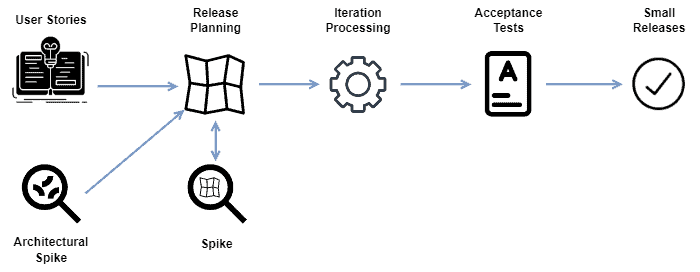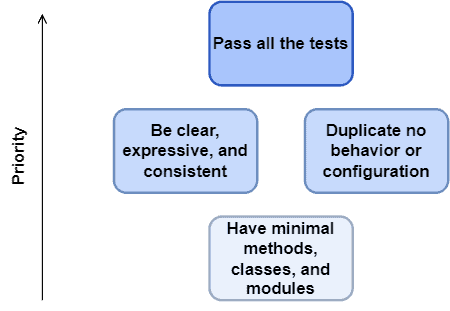1. 简介
面对同一个问题,不同开发者往往会采用不同的解决方案。 这在软件开发中是正常现象。但在大型项目、多人协作的团队中,为了提高沟通效率,往往需要遵循一些统一的开发标准。这些标准的核心目的,是通过代码本身实现开发者之间的有效沟通。
在本教程中,我们将探讨极限编程(eXtreme Programming,简称 XP)中的“简单设计四大准则”。首先我们会简要介绍 XP 方法论,然后逐一分析这四个准则的实际含义,最后进行总结。
2. 极限编程(XP)方法论
极限编程是一种采用敏捷开发理念的软件开发方法。 它的核心在于通过迭代式开发流程,以低复杂度的行动实现软件的快速交付。
XP 的流程透明且强调责任明确。其特点包括:
- 所有项目参与者都被视为合作伙伴,团队协作至关重要;
- XP 采用五个核心阶段:规划、管理、设计、编码和测试。
具体流程如下:
- 规划(Planning):基于用户故事制定短期发布计划,这是每次迭代的起点;
- 管理(Managing):通过每日站会协调团队和项目进展;
- 设计(Designing):使用重构、CRC 卡片、Spike 解决方案等技术进行高效设计;
- 编码(Coding):强调持续沟通、持续集成、代码规范和结对编程;
- 测试(Testing):以单元测试为核心,必须通过所有测试才能发布。
下图展示了 XP 的整体流程概览:

总结来说,XP 的五大核心价值观是:沟通、简洁、反馈、尊重和勇气。
在本文中,我们重点探讨“简洁”这一价值观,以及它如何体现在 XP 的各个阶段和开发流程中。
3. 简单设计的核心理念
什么是“简单”?这个问题并不容易回答。 是指用最直观的方法解决问题?还是用最少的操作实现功能?不同的角度可能会有不同的答案。
极限编程提供了一套明确的标准,用于判断代码是否“简单”。这四个标准构成了 XP 的“简单设计四大准则”:
✅ 通过所有测试
✅ 代码清晰、表达性强且一致
✅ 没有重复的行为或配置
✅ 方法、类和模块数量最少
这些准则是 XP 中实现可持续开发、易于维护和升级软件的关键。尽管没有严格的优先级顺序,但很多开发者认为第一个准则(通过所有测试)最为关键。
下图展示了这四个准则的常见优先级排序:

接下来我们逐一分析这四个准则的具体含义。
3.1 通过所有测试(Pass All the Tests)
这是 XP 简单设计中最基础、最核心的一条准则。
在 XP 中,单元测试是头等公民。 所有开发阶段和迭代都依赖于测试结果。只有通过所有测试,才表示功能开发完成。
- ✅ 测试确保了代码行为符合预期;
- ✅ 避免遗漏必要功能或添加不必要的功能,从而防止代码复杂化。
通过测试,开发者才能明确知道开发是否完成。
3.2 代码清晰、表达性强且一致(Be Clear, Expressive, and Consistent)
这条准则强调的是代码的可读性和意图表达。
在 XP 中,“简洁”不仅意味着功能实现简单,更意味着代码本身要易于理解。这要求团队成员能够高效沟通,而代码是沟通的主要载体。
实现方式包括:
- ✅ 使用有意义的变量名、方法名;
- ✅ 编写清晰的注释;
- ✅ 遵循统一的编码规范;
- ✅ 使用设计模式、封装等手段提升表达力。
一句话总结:代码不仅要让机器运行,也要让其他程序员轻松理解。
3.3 没有重复的行为或配置(Duplicate No Behavior or Configuration)
重复是代码复杂化的罪魁祸首之一。 XP 强烈反对重复逻辑、配置或数据。
- ✅ 所有行为应在代码中只出现一次;
- ✅ 重复会导致维护困难、出错率高、升级成本大。
要实现这一点,可以:
- ✅ 在设计阶段就考虑复用性;
- ✅ 使用封装、抽象、策略模式等设计手段;
- ✅ 通过重构消除重复代码。
重构是解决重复问题的重要手段,也是 XP 中最核心的实践之一。
3.4 方法、类和模块数量最少(Have Minimal Methods, Classes, and Modules)
这条准则可以看作是对前三条的补充:如果某段代码无法满足前三条准则,那它就不应该存在。
这意味着:
- ✅ 不要为“未来可能用到”的功能提前编码;
- ✅ 类和方法应职责单一、功能明确;
- ✅ 避免过度设计。
例如,一个类应该只做一件事,并且把它做好(Single Responsibility Principle)。
但注意:最小化数量 ≠ 合并功能。 类和方法的划分应以职责为依据,而不是为了“减少数量”。
4. 总结
在本文中,我们详细探讨了 XP 方法论中“简单设计”的四大准则:
- ✅ 通过所有测试
- ✅ 代码清晰、表达性强且一致
- ✅ 没有重复的行为或配置
- ✅ 方法、类和模块数量最少
这四个准则并非硬性规定,而是一套灵活的指导原则。它们适用于多种编程范式和语言,能够帮助我们构建出易于维护、长期可持续发展的软件系统。
XP 的简单设计准则,是构建高质量代码的重要基石。
只要在日常开发中持续践行这些原则,就能显著提升代码质量与团队协作效率。